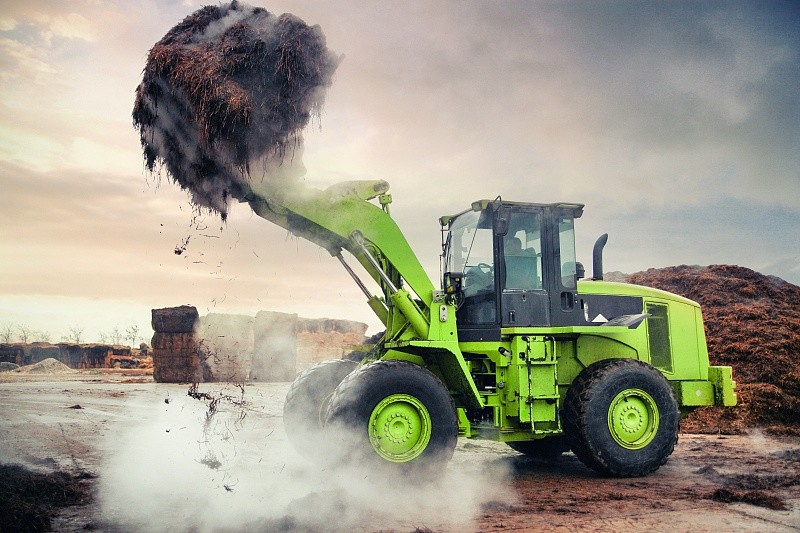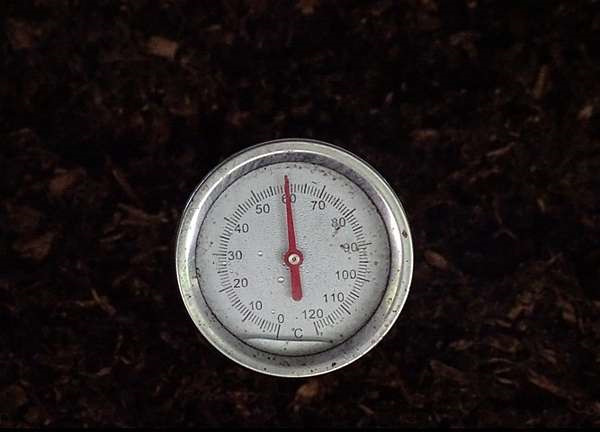1. Overview
Any kind of qualified high-quality organic compost production must go through the composting fermentation process. Composting is a process in which organic matter is degraded and stabilized by microorganisms under certain conditions to produce a product suitable for land use.
Composting, an ancient and simple method of treating organic waste and making fertilizer, has attracted much attention in many countries because of its ecological significance, it also brings benefits to agricultural production. It has been reported that soil-borne diseases can be controlled by using decomposed compost as a seedbed. After the high-temperature stage of the composting process, the number of antagonistic bacteria can reach a very high level, it is not easy to decompose, stable, and easy to be absorbed by crops. Meanwhile, the action of microorganisms can reduce the toxicity of heavy metals in a certain range. It can be seen that composting is a simple and effective way to produce bio-organic fertilizer, which is beneficial to the development of ecological agriculture.
Why does compost work like this? The following is a more detailed description of the principles of composting:
2. Principle of organic compost fermentation
2.1 Conversion of organic matter during composting
The transformation of organic matter in compost under the action of microorganisms can be summarized into two processes: one is the mineralization of organic matter, that is, the decomposition of complex organic matter into simple substances, the other is the humification process of organic matter, that is, the decomposition and synthesis of organic matter to produce more complex special organic matter-humus. The two processes are carried out at the same time but in the opposite direction. Under different conditions, the intensity of each process is different.
2.1.1 Mineralization of organic matter
- Decomposition of nitrogen-free organic matter
Polysaccharide compounds (starch, cellulose, hemicellulose) are first hydrolyzed into monosaccharides by hydrolytic enzymes secreted by microorganisms. The intermediate products such as alcohol, acetic acid, and oxalic acid were not easy to accumulate, and finally formed CO₂ and H₂O, and released a lot of heat energy. If the ventilation is bad, under the action of the microbe, the monosaccharide will decompose slowly, produce less heat, and accumulate some intermediate products-organic acids. Under the condition of gas-repelling microorganisms, reducing substances such as CH₄ and H₂ can be produced.
- Decomposition from nitrogen-containing organic matter
Nitrogen-containing organic matter in compost includes protein, amino acids, alkaloids, hummus, and so on. Except for humus, most are easily decomposed. For example, protein, under the action of a protease secreted by the microorganism, degrades step by step, produces various amino acids, and then forms ammonium salt and nitrate respectively through ammoniation and nitration, which can be absorbed and utilized by plants.
- Transformation of phosphorus-containing organic compounds in compost
Under the action of a variety of saprophytic microorganisms, forms phosphoric acid, which becomes a nutrient that plants can absorb and utilize.
- Conversion of sulfur-containing organic matter
Sulfur-containing organic matter in the compost, through the role of microorganisms to produce hydrogen sulfide. Hydrogen sulfide is easy to accumulate in the environment of disliking gas, and it can be toxic to plants and microorganisms. But under well-ventilated conditions, hydrogen sulfide is oxidized to sulfuric acid under the action of sulfur bacteria and reacts with the base of compost to form sulfate, which not only eliminates the toxicity of hydrogen sulfide, and becomes sulfur nutrients that plants can absorb. Under the condition of bad ventilation, the sulfation occurred, which caused H₂S to be lost and poison the plant. In the process of compost fermentation, the aeration of compost can be improved by turning over the compost regularly, so the anti-sulfuration can be eliminated.
- Conversion of lipids and aromatic organic compounds
Such as tannin and resin, is complex and slow to decompose, and the final products are also CO₂ and water Lignin is a stable organic compound containing plant materials (such as bark, sawdust, etc.) in composting. It is very difficult to decompose because of its complex structure and aromatic nucleus. Under the condition of good ventilation, the aromatic nucleus can be converted into quinoid compounds through the action of fungi and Actinomycetes, which is one of the raw materials for the resynthesis of humus. Of course, these substances will continue to be broken down under certain conditions.
In summary, the mineralization of composted organic matter can provide quick-acting nutrients for crops and microorganisms, provide energy for microbial activities, and prepare basic materials for the humification of composted organic matter. When composting is dominated by aerobic microorganisms, the organic matter rapidly mineralizes to produce more carbon dioxide, water, and other nutrients, decomposes quickly and thoroughly, and releases a lot of heat energy The decomposition of organic matter is slow and often incomplete, releasing less heat energy, and the decomposition products are in addition to plant nutrients, it is easy to accumulate organic acids and reductive substances such as CH₄, H₂S, PH₃, H₂, etc. . The tipping of compost during fermentation is therefore also intended to change the type of microbial activity to eliminate harmful substances.
2.1.2 Humification of organic matter
There are many theories about the formation of humus, which can be roughly divided into two stages: the first stage, when organic residues break down to form the raw materials that make up the humus molecules, in the second stage, polyphenol is oxidized to quinone by the Polyphenol oxidase secreted by the microorganism, and then quinone is condensed with amino acid or peptide to form humus monomer. Because phenol, quinine, amino acid variety, mutual condensation is not the same way, so the formation of humus monomer is also diverse. Under different conditions, these monomers further condense to form molecules of different sizes.
2.2 Conversion of heavy metals during composting
The municipal sludge is one of the best raw materials for composting and fermentation because it contains rich nutrients and organic matter for the growth of crops. But municipal sludge often contains heavy metals, these heavy metals generally refer mercury, chromium, cadmium, lead, arsenic, and so on. Microorganisms, especially bacteria and fungi, play an important role in the biotransformation of heavy metals. Although some microorganisms can change the presence of heavy metals in the environment, make chemicals more toxic and cause serious environmental problems, or concentrate heavy metals, and accumulate through the food chain. But some microbes can help improve the environment by removing heavy metals from the environment through direct and indirect actions. Microbial transformation of HG includes three aspects, i. e. methylation of inorganic mercury (Hg₂+), reduction of inorganic mercury (Hg₂+) to HG0, decomposition, and reduction of methylmercury and other organic mercury compounds to HG0. These microorganisms capable of converting inorganic and organic mercury into elemental mercury are called mercury-resistant microorganisms. Although microorganisms can not degrade heavy metals, they can reduce the toxicity of heavy metals by controlling their transformation pathway.
2.3 Composting and fermentation process
Composting is a form of waste stabilization, but it requires special humidity, aeration conditions, and microorganisms to produce the right temperature. The temperature is thought to be higher than 45 °C (about 113 degrees Fahrenheit), keeping it high enough to inactivate pathogens and kill weed seeds. The decomposition rate of residual organic matter after reasonable composting is low, relatively stable, and easy to be absorbed by plants. The odor can be greatly reduced after composting.
The composting process involves many different types of microorganisms. Due to the change in raw materials and conditions, the quantity of various microorganisms is also changing constantly, so no microorganisms always dominate the composting process. Each environment has its specific microbial community, and microbial diversity enables composting to avoid system collapse even when external conditions change.
The composting process is mainly carried out by microorganisms, which is the main body of composting fermentation. The microbes involved in composting come from two sources: a large number of microbes already present in organic waste, and an artificial microbial inoculum. Under certain conditions, these strains have a strong ability to decompose some organic wastes and have the characteristics of strong activity, rapid propagation, and rapid decomposition of organic matter, which can speed up the composting process, shorten the composting reaction time.
Composting is generally divided into aerobic composting and anaerobic composting two kinds. Aerobic composting is the decomposition process of organic materials under aerobic conditions, and its metabolic products are mainly carbon dioxide, water, and heat; anaerobic composting is the decomposition process of organic materials under anaerobic conditions, the final metabolites of anaerobic decomposition are methane, carbon dioxide and many low molecular weight intermediates, such as organic acids.
The main microbial species involved in the composting process are bacteria, fungi, and actinomycetes. These three kinds of microorganisms all have mesophilic bacteria and hyperthermophilic bacteria.
During the composting process, the microbial population changed alternately as follows: low and medium temperature microbial communities changed to medium and high-temperature microbial communities, and medium and high-temperature microbial communities changed to the medium and low-temperature microbial community. With the extension of composting time, bacteria gradually decreased, actinomycetes gradually increased, and mold and yeast at the end of composting significantly reduced.
The fermentation process of organic compost can be simply divided into four stages:
2.3.1 During the heating stage
During the initial stage of composting, the microorganisms in the compost are mainly of moderate temperature and good atmosphere, the most common of which are non-spore bacteria, spore bacteria, and mold. They start the fermentation process of compost, and decompose organic matter (such as simple sugar, starch, protein, etc.) vigorously under the condition of a good atmosphere, producing a lot of heat and continuously raising the temperature of compost, the rise from about 20 °C (about 68 degrees Fahrenheit) to 40 °C (about 104 degrees Fahrenheit) is called the febrile stage, or the intermediate temperature stage.
2.3.2 During high temperatures
Warm microorganisms gradually take over from the warm species and the temperature continues to rise, usually above 50 °C (about 122 degrees Fahrenheit) within a few days, into the high-temperature phase. In the high-temperature stage, the good heat actinomycetes and the good heat fungus become the main species. They break down the complex organic matter in the compost, such as cellulose, hemicellulose, pectin, and so on. The heat builds up and the compost temperature rises to 60 °C (about 140 degrees Fahrenheit), this is very important to speed up the composting process. Improper composting of compost, only a very short high-temperature period, or no high temperature, and therefore very slow maturity, in half a year or more period is not half mature state.
2.3.3 During the cooling phase
After a certain period during the high-temperature phase, most of the cellulose, hemicellulose, and pectin substances have been decomposed, leaving behind hard-to-decompose complex components (e.g. lignin) and newly formed humus, the activity of micro-organisms decreased and the temperature gradually decreased. When the temperature drops below 40 °C (about 104 degrees Fahrenheit), mesophilic microorganisms become the dominant species
If the cooling stage comes early, the composting conditions are not ideal and the decomposition of plant materials is not sufficient. At this point can turn the pile, a pile material mixing, so that it produces second heating, heating, to promote composting.
2.3.4 Maturity and fertilizer preservation stage
After composting, the volume decreases and the temperature of compost drops to a little higher than the temperature of the air, then the compost should be pressed tightly, resulting in an anaerobic state and weakening the mineralization of organic matter, to keep fertilizer.
In short, the fermentation process of organic compost is the process of microbial metabolism and reproduction. The process of microbial metabolism is the process of organic matter decomposition. Decomposition of organic matter produces energy, which drives the composting process, raises the temperature, and dries the wet substrate.
If you have any other questions or needs, please contact us by the following ways:
whatsapp: +86 13822531567
Email: sale@tagrm.com
Post time: Apr-11-2022


